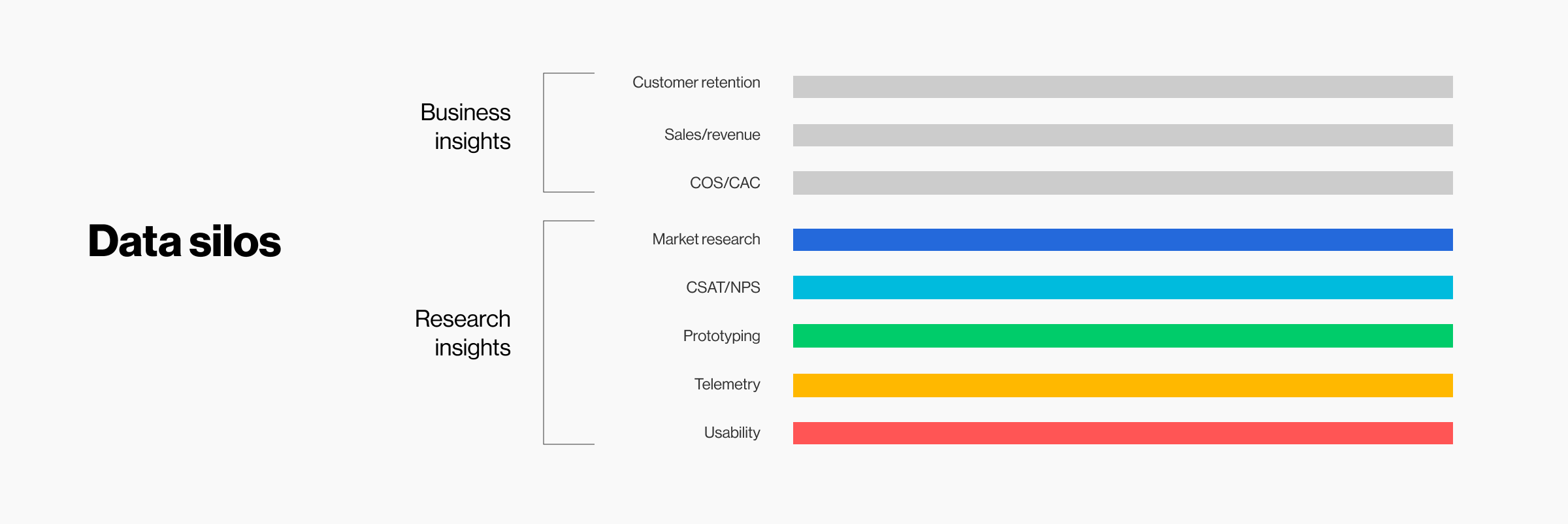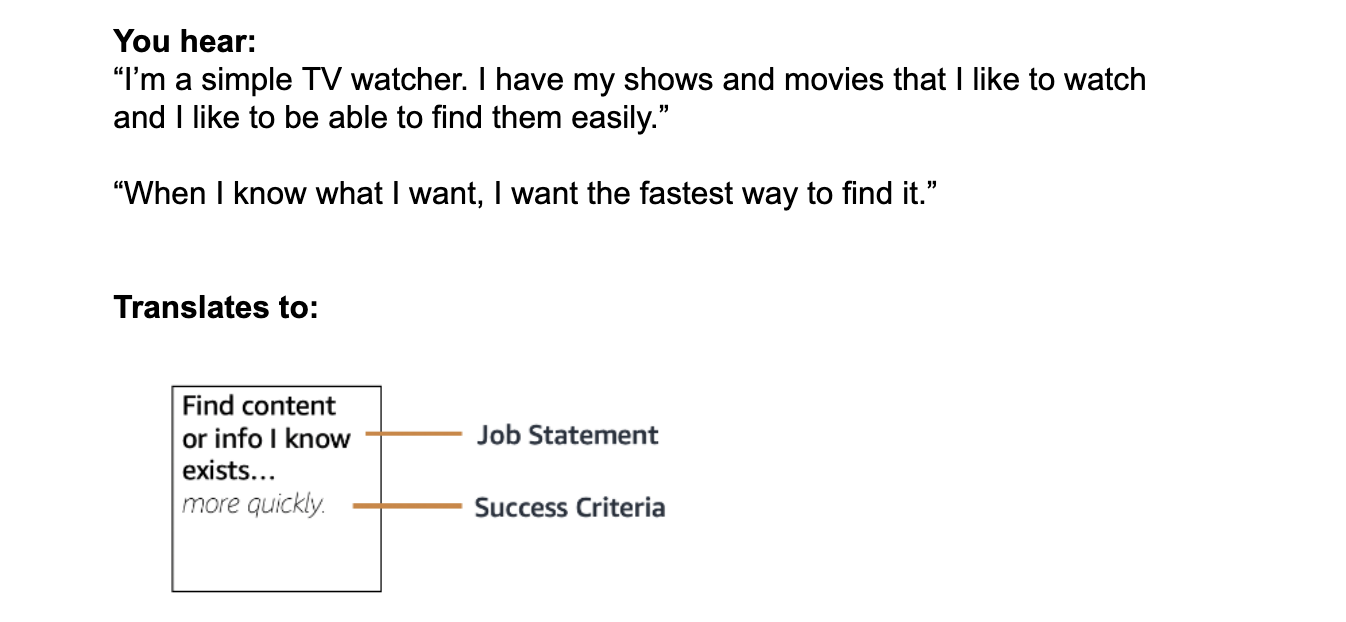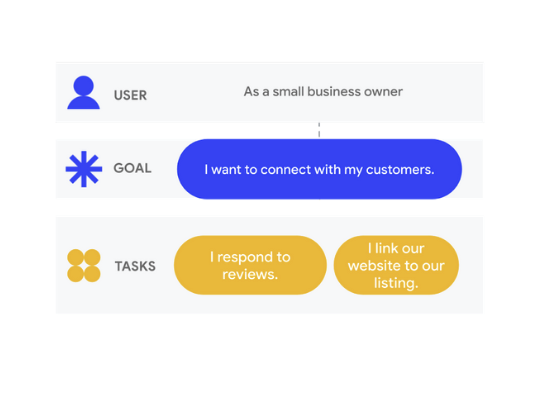
Analyzing customer feedback is likely top-of-mind if you're responsible for creating and managing products. With more feedback available than ever, you’re also juggling more data sets.
For any product, you might have multiple research studies happening simultaneously, each measuring different features and delivering results in various formats. While each set of insights makes sense on its own, piecing them all together can quickly become overwhelming. Then, you add business metrics like sales costs and revenue on top of your CX metrics, and data silos start to pile up.

According to Forrester's recent Digital CX and Design Trends report, it's common for designers, engineers, and product managers to "struggle to synthesize diverse sources of data."
That's where measurement frameworks like customer success outcomes (CSOs) come in. CSOs help break down data silos, turn research insights into action, and establish clear customer experience metrics.
What are Customer Success Outcomes (CSOs)?
CSOs (aka jobs to be done or customer experience outcomes at Amazon) are statements made up of two parts:
- What the product does to address a need
- How the customer judges success
When mapped to a customer journey and paired with evaluative research, CSOs can help you make sense of diverse data sets.

For example, say we’re designing a new app called FamilyTrip that helps parents discover, plan, and book family vacations. One CSO that describes a parent's need would be to: “find enriching stops along the way with ease.”
- “Finding enriching stops along the way” = what the product does to address a need
- “with ease” = how the customer judges success

Not every CSO needs to apply to your entire target audience. Instead, focus on creating CSOs that address specific aspects of the overall customer experience.
Other types of CX measurement frameworks
Businesses are tracking multiple data streams and feedback sources, those may include Net Promoter Scores (NPS), Customer Satisfaction (CSAT), Time to Resolution (TTR), customer retention, churn rate, or usability metrics.
These data streams are often siloed, with different teams managing different parts of the feedback reporting. Executives have no way to decipher the information together and align it to an overarching product roadmap strategy for improvements.
There are lots of different types of frameworks to help bring these data silos together for a more holistic picture of the customer experience.
Jobs to be Done (JTBD)
Jobs to be Done (JTBD) are formulaic statements for identifying the reasons why people use or need a product, what they are trying to achieve, and prioritize them for clear product roadmaps.
Jobs to be Done statements are made up of the following components: direction, performance metric, object of control, and contextual clarifier. A typical output of a series of JTBD statements is a Job Map, similar to a journey map.
Here's what a Jobs to be Done (JTBD) statement might look like:

Customer Experience Outcomes (CXOs)
Customer Experience Outcomes or CXO, are formulaic statements for operationalizing customer needs within a given domain of customer experience and then used throughout the development process.
CXOs are made up of two components, a job the product must do to address the need, and a set of criteria that the customer will use to judge how well the product does the job.
A Customer Experience Outcome (CXO) might look like the following:

Critical User Journeys (CUJs)
A Critical User Journey, or CUJ, are formulaic statements used to articulate critical user goals and the steps required to achieve that goal. Google uses this specific framework and language for their internal product development and evaluation research.
CUJs have two main statement types, the goal and the tasks. The goal is a higher level statement that communicates users’ needs. Tasks are the steps users go through to accomplish that goal. Unlike JTBD or CXOs, they do not include a success metric.
Here's what a Critical User Journey (CUJ) might look like:

How can CX measurement frameworks help break down data silos?
CX measurement frameworks like CSOs can help you connect the dots between different research sets. Organize your customer research by the level of insights they provide.

For example, market research insights and CX scores like NPS and CSAT operate at the "relationship level," offering a high-level view of your customer relationships.
The other common layer is the "interaction level," which focuses on specific product workflows, features, and touchpoints through concept and usability testing.
Understanding how these "relationship" and "interaction" insights connect is the challenge. Without aligning your research silos, it’s tough to determine which feature improvements will drive engagement, satisfaction, retention, and growth.
CSOs tie your interaction and relationship level together by giving you a standard set of outcomes for measuring the customer experience over time.
Creating effective CX measurement frameworks
Each framework has its own nuances that have to be slightly adjusted during the research process, but generally, the process is as follows:
Define the space: Identify the problem space the product should support.
Understand the space: Use qualitative research to understand process, needs, and pain points.
Create statements: Transform research findings into statements.
Prioritize statements: After creating the statements, they need to be prioritized and validated to focus the team. Depending on the project this is done through workshops and/or surveys.
Map to the Journey: Map the prioritized statements to the different parts of the journey.
Measure over time: When doing concept or usability testing, have participants evaluate the products based on the statements.
A deeper dive: how to create CSOs and add them to your product strategy

Step 1: Define your CSOs
You can derive your outcome statements from the insights you gather during foundational research. Each CSO you create should include a “job” and a success measure.

What the product does (or the “job) can be thought of in a few ways:
- Jobs to be done
- UX goals
- Desired outcome statements
Each CSO should include a single verb and some form of directionality — words like “less,” “more,” “faster,” “easier,” “maximize,” or “minimize.” Here are some other CSOs we might create for FamilyTrip:
- View your daily planned itinerary quickly
- Choose food stops that accommodate dietary restrictions with more confidence
- Share trip highlights with family and friends easily
Tips for defining CSOs:
- Revisit existing research: Your foundational research should tell you what customers want to achieve when they use your products and services.
- Conduct in-depth qualitative research: Qualitative interviews uncover your users' needs and pain points.
- Aim for 30-40 CSOs: Schedule an internal workshop with the co-researchers to review qualitative insights and generate your outcome statements.
- Map your CSOs to a journey: Consider how you'll map your outcome statements to a journey map. This will help you leverage them to target specific aspects of the experience.

Step 2: Integrate CSOs into your evaluative research
Once you map your CSOs to a customer journey, leverage them as part of an evaluative research program like usability testing and concept evaluation.
By combining your CSO assessment with evaluative research, you gain insight into your performance on the cx metrics that matter most to your customers.

Your CSO work isn't done yet. Revisit your outcome statements regularly to keep improving your product and measuring customer experience success.

Step 3: Build CSOs into your cx measurement program
CSOs should be part of ongoing CX measurement. One way to do this is by setting up a recurring customer survey. Here's an example of how that could look for FamilyTrip.

Once you have your survey insights, prioritize which problems to address first. Strategies for prioritizing CSOs include:
- Segmenting by persona
- Using satisfaction and value metrics to organize into opportunity types
- Correlating with engagement or other usage metrics
Implementing a new CX metric
Incorporating CSOs into your strategy can have a big impact on your product success, just like it did for Prime Video. While many factors contribute to this success, aligning the team around CX metrics played a significant role.
Start by conducting foundational research to understand your customers and define your CSOs. Then, evaluate your CSOs throughout every research phase, from concept to usability testing. Finally, embed CSOs into your ongoing CX measurement to track progress and identify product gaps.
Reach out to learn more about building and testing CSOs as part of your product strategy!



